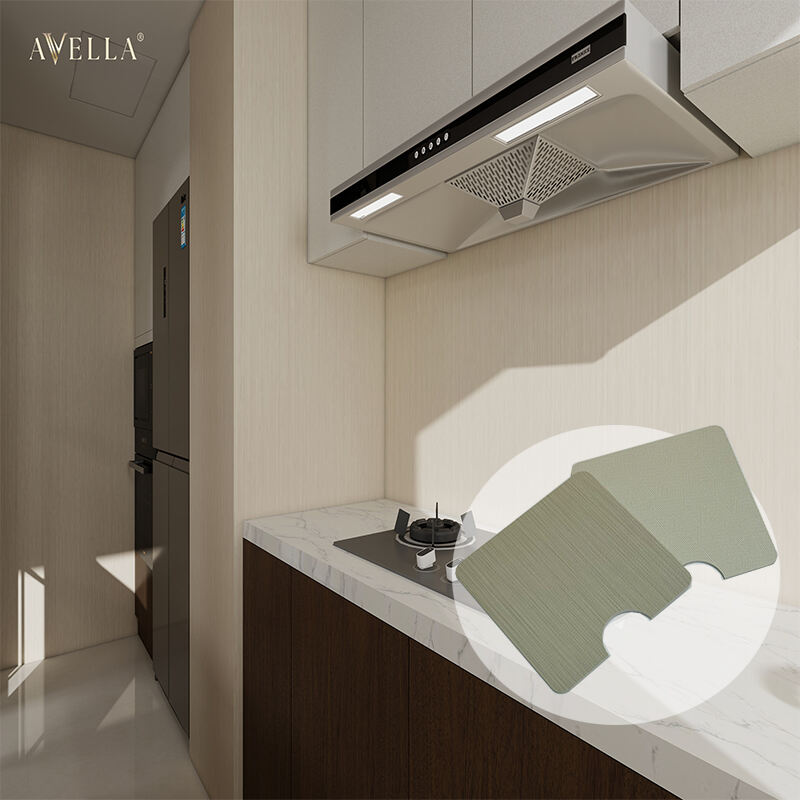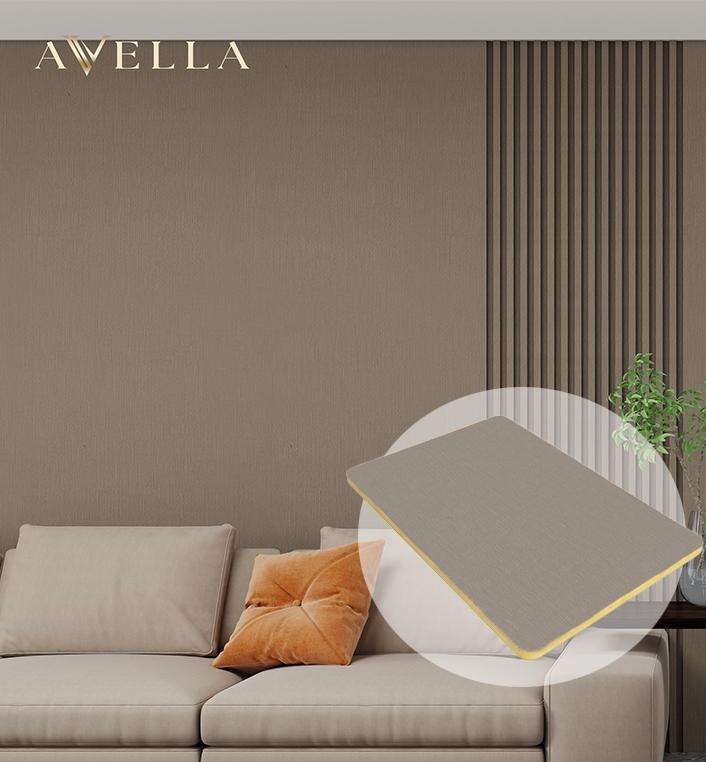আধুনিক spc ওয়াল প্যানেল সমাধান এবং ঐতিহ্যবাহী ওয়াল কভারিং-এর মধ্যে বিতর্ক আরও তীব্র হয়েছে কারণ গৃহমালিক এবং বাণিজ্যিক সম্পত্তি ডেভেলপারদের অভ্যন্তরীণ ডিজাইন প্রকল্পের জন্য খরচ-কার্যকর, টেকসই বিকল্প খুঁজছেন। প্রতিটি বিকল্পের আর্থিক প্রভাব বোঝার জন্য প্রাথমিক খরচ, ইনস্টলেশনের খরচ, রক্ষণাবেক্ষণের প্রয়োজনীয়তা এবং দীর্ঘমেয়াদী মূল্যের প্রস্তাবনা পর্যালোচনা করা প্রয়োজন। এই ব্যাপক বিশ্লেষণে উদ্ভাবনী সিনথেটিক উপকরণগুলি মোট মালিকানা খরচের দিক থেকে কতটা চিত্র, পেইন্ট এবং কাপড়ের কভারিংয়ের তুলনায় ভালো তা দেখায়।

ওয়াল কভারিংয়ের বিকল্পগুলি মূল্যায়নের সময় উপকরণের খরচ মোট বিনিয়োগের সমীকরণের মাত্র একটি উপাদান। ঐতিহ্যবাহী সমাধানগুলি প্রাথমিকভাবে কম খরচের মনে হলেও, প্রস্তুতি, পেশাদার ইনস্টলেশন এবং চলমান রক্ষণাবেক্ষণের সাথে জড়িত লুকানো খরচগুলি প্রায়শই অর্থনৈতিক ভারসাম্যকে উল্লেখযোগ্যভাবে পরিবর্তন করে। আধুনিক কম্পোজিট প্যানেলগুলি দীর্ঘস্থায়ীত্ব এবং প্রয়োগের সহজতার ক্ষেত্রে সুস্পষ্ট সুবিধা প্রদান করে যা সময়ের সাথে পরিমাপযোগ্য সাশ্রয়ে রূপান্তরিত হয়।
প্রাথমিক উপকরণ খরচ বিশ্লেষণ
SPC প্যানেল মূল্য কাঠামো
এর মূল্য পরিসর এসপিসি দেওয়াল প্যানেল পণ্যগুলির ডিজাইনের জটিলতা, পুরুত্বের বিবরণ এবং পৃষ্ঠের চিকিত্সার গুণমানের উপর নির্ভর করে সাধারণত প্রতি বর্গমিটার 8 থেকে 25 ডলারের মধ্যে পড়ে। উন্নত টেক্সচার বা বিশেষ ফিনিশ সহ প্রিমিয়াম সংগ্রহগুলি উচ্চতর মূল্য দাবি করে, যখন মৌলিক ডিজাইনগুলি বাজেট-সচেতন প্রকল্পের জন্য অর্থনৈতিক বিকল্প প্রদান করে। বড় ইনস্টলেশনের জন্য বাল্ক ক্রয় প্রায়শই ইউনিট খরচকে 15-20% হ্রাস করে।
সাম্প্রতিক বছরগুলিতে উৎপাদনের অর্থনীতির প্রসার ধাপে ধাপে দাম হ্রাসের কারণ হয়েছে, যা কৃত্রিম প্যানেলগুলিকে মাঝারি শ্রেণির ঐতিহ্যবাহী উপকরণের সাথে প্রতিযোগিতামূলক করে তুলেছে। কারখানাতে উৎপাদিত প্যানেলগুলির আদর্শ মাত্রা এবং সঙ্গতিপূর্ণ মান অনিয়মিত আকৃতির ঐতিহ্যবাহী উপকরণগুলি কাটা ও ফিট করার সময় যে অপচয় হয় তা দূর করে। পরিমাণভিত্তিক ছাড় এবং প্রচারমূলক মূল্য নির্ধারণ ঠিকাদার এবং উন্নয়নকারীদের জন্য মূল্যের প্রস্তাবকে আরও উন্নত করে।
ঐতিহ্যবাহী উপকরণের খরচ
ঐতিহ্যবাহী ওয়ালপেপারের দাম প্রতি বর্গমিটারে 3 থেকে 50 ডলার পর্যন্ত হয়, যেখানে ডিজাইনার সংগ্রহ এবং বিশেষ উপকরণগুলি উচ্চতর মূল্য নির্ধারণ করে। গুণগত পেইন্ট সিস্টেমগুলি কেবল উপকরণের খরচে প্রতি বর্গমিটারে 2 থেকে 8 ডলার হয়, যদিও একাধিক স্তর এবং প্রাইমারের প্রয়োজনীয়তা এই খরচকে দ্বিগুণ করে দিতে পারে। কাপড়ের ওয়াল কভারিং-এর মূল্য আরও বিস্তৃত, লাক্সারি ডিজাইনার বিকল্পগুলির জন্য প্রতি বর্গমিটারে 15 থেকে 100 ডলার পর্যন্ত হয়।
প্রচলিত উপকরণের দামের পরিবর্তনশীলতা নির্ভুল প্রকল্প বাজেট করার ক্ষেত্রে চ্যালেঞ্জ তৈরি করে, বিশেষ করে প্যাটার্ন মিলানো, অপচয়ের হার এবং উৎপাদন ব্যাচগুলির মধ্যে গুণগত অসঙ্গতি বিবেচনা করার সময়। পেশাদার-গ্রেড আঠা, প্রাইমার এবং পৃষ্ঠতল প্রস্তুতির যৌগগুলি কাঁচামালের খরচে 20-30% যোগ করে, ব্যাপক ইনস্টলেশনের জন্য অতিরিক্ত বাজেট বিবেচনা তৈরি করে।
ইনস্টলেশন খরচের তুলনা
SPC সিস্টেমের জন্য শ্রমের প্রয়োজন
SPC ওয়াল প্যানেল সিস্টেমের পেশাদার ইনস্টলেশনের জন্য সাধারণত প্রতি 10 বর্গমিটারে 2-4 ঘন্টা সময় লাগে, যা ঘরের জটিলতা এবং ইনস্টলারের অভিজ্ঞতার উপর নির্ভর করে। ক্লিক-লক বা আঠা মাউন্টিং সিস্টেমগুলি বিশেষায়িত যন্ত্র বা ব্যাপক পৃষ্ঠতল প্রস্তুতির প্রয়োজন দূর করে, যা শ্রম খরচ উল্লেখযোগ্যভাবে কমিয়ে দেয়। দক্ষ ইনস্টলারগুলি অধিকাংশ আবাসিক ঘর একদিনের মধ্যে সম্পন্ন করতে পারে, যা ব্যাঘাত এবং সংশ্লিষ্ট পরোক্ষ খরচ কমিয়ে দেয়।
সিনথেটিক প্যানেলগুলির হালকা গঠন এবং মডিউলার ডিজাইনের কারণে স্থাপন এবং পরিচালন করা দক্ষতার সঙ্গে সম্ভব হয়, যা ইনস্টলেশনের জন্য প্রয়োজনীয় শ্রমিকদের সংখ্যা কমিয়ে দেয়। আগে থেকে সমাপ্ত পৃষ্ঠতলগুলি রং করা বা ফিনিশিংয়ের ধাপগুলি ঘুচিয়ে দেয়, যা আরও বেশি দ্রুত ইনস্টলেশন প্রক্রিয়াকে সমর্থন করে। ঐতিহ্যবাহী বহু-ধাপযুক্ত প্রয়োগ পদ্ধতির তুলনায় এই দক্ষতা অর্জন শ্রম খরচে 30-50% সাশ্রয় করে।
ঐতিহ্যবাহী ইনস্টলেশনের জটিলতা
ওয়ালপেপার ইনস্টল করার জন্য ব্যাপক পৃষ্ঠতল প্রস্তুতির প্রয়োজন হয়, যার মধ্যে রয়েছে পরিষ্কার করা, প্রাইমিং এবং অসমতা মসৃণ করা—এগুলি প্রতি ঘরে 2-6 ঘন্টা সময় বাড়াতে পারে, যা দেয়ালের অবস্থার উপর নির্ভর করে। পেশাদার ওয়ালপেপার হ্যাঙ্গাররা ঘন্টায় 25-60 ডলার চার্জ করেন, আর প্যাটার্ন মেলানো এবং কোণার চিকিত্সা আরও বেশি সময় এবং দক্ষতা চায়। জটিল ডিজাইন বা টেক্সচারযুক্ত পৃষ্ঠতলের ক্ষেত্রে বিশেষায়িত ইনস্টলেশন পদ্ধতির প্রয়োজন হতে পারে, যা শ্রম খরচ আরও বাড়িয়ে দেয়।
পেইন্ট প্রয়োগের মধ্যে প্রাইমিং, বেস কোটিং এবং ফিনিশ কোটিং সহ একাধিক পর্যায় জড়িত, যার প্রতিটির জন্য প্রয়োগের মধ্যে শুকানোর সময় প্রয়োজন। পেশাদার পেইন্টাররা সাধারণত ঘরের আকার ও জটিলতার উপর নির্ভর করে প্রতি ঘরে 300-800 ডলার চার্জ করেন, আর প্রিমিয়াম ফিনিশ এবং একাধিক রঙ খরচকে উল্লেখযোগ্যভাবে বৃদ্ধি করে। ত্রুটিমুক্ত ফলাফলের জন্য পৃষ্ঠতল প্রস্তুতি, মাস্কিং এবং পরিষ্কার-আরামদায়ক কাজগুলি ঐতিহ্যবাহী পেইন্টিং প্রকল্পে উল্লেখযোগ্য সময় যোগ করে।
দীর্ঘমেয়াদি রক্ষণাবেক্ষণের বিবেচনা
দীর্ঘস্থায়িত্ব এবং প্রতিস্থাপন চক্র
SPC ওয়াল প্যানেল ইনস্টলেশনের দৃঢ় নির্মাণ আর্দ্রতা, স্ক্র্যাচ এবং আঘাতের ক্ষতির বিরুদ্ধে প্রতিরোধ প্রদান করে যা সাধারণত ঐতিহ্যবাহী ওয়াল কভারিংয়ের ক্ষেত্রে দেখা যায়। গবেষণাগার পরীক্ষায় সাধারণ আবাসিক অবস্থার অধীনে 15-25 বছরের সেবা আয়ুর প্রত্যাশা দেখায়, যা উচ্চমানের ওয়ালপেপারের জন্য 5-10 বছর এবং পেইন্ট করা পৃষ্ঠের জন্য 3-7 বছরের তুলনায় বেশি। এই দীর্ঘস্থায়ী স্থায়িত্ব প্রতিস্থাপনের ঘনত্ব এবং সংশ্লিষ্ট ব্যাঘাতের খরচ হ্রাস করে।
স্থানীয় ক্ষতির ক্ষেত্রে ব্যক্তিগত প্যানেল প্রতিস্থাপনের ক্ষমতা উল্লেখযোগ্য সুবিধা প্রদান করে, যা পুরো দেয়াল পুনর্নবীকরণ ছাড়াই লক্ষ্যবিশিষ্ট মেরামতের অনুমতি দেয়। আঘাত হেতু ঐতিহ্যবাহী উপকরণগুলি সাধারণত খণ্ড বা ঘরজুড়ে প্রতিস্থাপনের প্রয়োজন হয়, যা রক্ষণাবেক্ষণ কাজের জন্য উপকরণ এবং শ্রম উভয় খরচই বৃদ্ধি করে। সিনথেটিক প্যানেলগুলির মডিউলার ডিজাইন ন্যূনতম অপচয়ের সাথে ভবিষ্যতের নবীকরণ এবং স্টাইল আপডেটের সুবিধা প্রদান করে।
পরিষ্কার এবং রক্ষণাবেক্ষণের প্রয়োজনীয়তা
SPC ওয়াল প্যানেলের তলদেশের নিয়মিত রক্ষণাবেক্ষণে সাধারণ গৃহস্থালির ক্লিনার ব্যবহার করে সহজ পরিষ্কারের প্রয়োজন হয়, যাতে কোনো বিশেষ পণ্য বা পেশাদার পরিষেবার প্রয়োজন হয় না। অ-সরিষ্ণু পৃষ্ঠতল দাগ এবং আর্দ্রতা শোষণের বিরুদ্ধে প্রতিরোধ করে, দীর্ঘ সময় ধরে কম চেষ্টায় চেহারার গুণমান বজায় রাখে। বাণিজ্যিক ইনস্টলেশনগুলি টেক্সচারযুক্ত ঐতিহ্যবাহী পৃষ্ঠের তুলনায় কম জানিটোরিয়াল খরচ এবং উন্নত স্বাস্থ্য মানের সুবিধা পায়।
রক্ষণাবেক্ষণের সময় ক্ষতি এড়াতে প্রায়শই বিশেষ পরিষ্করণ পণ্য এবং কৌশলের প্রয়োজন হয় ঐতিহ্যগত দেয়ালের আবরণের। ওয়ালপেপারের সিম এবং টেক্সচারযুক্ত তলগুলি ধুলো এবং দূষণকারী পদার্থ আটকে রাখে, যার ফলে বাণিজ্যিক প্রয়োগে পেশাদার পরিষ্করণ পরিষেবার প্রয়োজন হয়। পেইন্ট করা তলগুলির নিয়মিত ছোটখাটো মেরামত এবং সম্পূর্ণ পুনরায় রং করার প্রয়োজন হয়, যা পরিচালন বাজেটে অব্যাহত রক্ষণাবেক্ষণ খরচ যোগ করে।
মোট মালিকানা খরচ বিশ্লেষণ
পাঁচ বছরের আর্থিক পূর্বাভাস
পাঁচ বছরের একটি ব্যাপক খরচ বিশ্লেষণ দেখায় যে SPC ওয়াল প্যানেল ইনস্টলেশন সাধারণত তৃতীয় বছরে ঐতিহ্যগত বিকল্পগুলির সমান খরচ অর্জন করে, যদিও প্রাথমিক বিনিয়োগের প্রয়োজনীয়তা বেশি থাকে। হ্রাসপ্রাপ্ত রক্ষণাবেক্ষণ, প্রতিস্থাপন এবং মেরামতের খরচ সময়ের সাথে সঞ্চিত সাশ্রয়ের মাধ্যমে প্রিমিয়াম উপকরণের মূল্য কাটাতে সক্ষম হয়। হ্রাসপ্রাপ্ত ডাউনটাইম এবং পরিচালন ব্যাঘাতের কারণে বাণিজ্যিক প্রয়োগগুলিতে আরও বড় অর্থনৈতিক সুবিধা দেখা যায়।
সিনথেটিক প্যানেলগুলির উন্নত অন্তরণ বৈশিষ্ট্য থেকে শক্তি দক্ষতা সুবিধা পাওয়া যায়, যা তাপ এবং শীতলীকরণের খরচ হ্রাসের মাধ্যমে অতিরিক্ত সাশ্রয় ঘটায়। কম্পোজিট উপকরণগুলির তাপীয় কর্মক্ষমতার বৈশিষ্ট্য পরিমাপযোগ্য ইউটিলিটি খরচ হ্রাস করে, যা মোট মালিকানার খরচের উপর 5-10% পর্যন্ত প্রভাব ফেলে।
অনুশীলনের উপর ফিরতি পরিমাপ
আধুনিক SPC ওয়াল প্যানেল ইনস্টলেশন থেকে সম্পত্তির মান বৃদ্ধি প্রায়শই বাস্তব সম্পত্তি বাজার বিশ্লেষণ অনুযায়ী 15-25% পর্যন্ত অতিক্রম করে। আধুনিক চেহারা এবং কম রক্ষণাবেক্ষণের বৈশিষ্ট্য ক্রেতা এবং ভাড়াটেদের কাছে আকর্ষণীয়, যা উচ্চতর ভাড়া এবং বিক্রয়মূল্যকে সমর্থন করে। আকর্ষণীয়, টেকসই অভ্যন্তরীণ সজ্জার কারণে বাণিজ্যিক সম্পত্তিগুলি ভাড়াটেদের সন্তুষ্টি বৃদ্ধি এবং শূন্যতার হার হ্রাস পায়।
বাণিজ্যিক ইনস্টলেশনের জন্য কর সুবিধা এবং অবচয়ের সুবিধাগুলি অতিরিক্ত আর্থিক পুরস্কার হিসাবে কাজ করে যা প্রকল্পের অর্থনীতিকে আরও ভালো করে তোলে। দীর্ঘ সেবা জীবন এবং কম রক্ষণাবেক্ষণের প্রয়োজনীয়তা কৃত্রিম প্যানেল সিস্টেমগুলিকে ঐতিহ্যবাহী আবরণ উপকরণগুলির তুলনায় অনুকূল হিসাবরক্ষণ চিকিত্সার যোগ্যতা প্রদান করে। এই আর্থিক সুবিধাগুলি ব্যবসায়িক প্রয়োগের জন্য নগদ প্রবাহ এবং বিনিয়োগের উপর রিটার্ন গণনাকে আরও বাড়িয়ে তোলে।
বাজারের প্রবণতা এবং ভবিষ্যতের বিবেচনা
প্রযুক্তি উন্নয়নের প্রভাব
SPC ওয়াল প্যানেল উৎপাদনে চলমান নবাচারগুলি উৎপাদন খরচ কমিয়ে আনার পাশাপাশি ক্রমাগত পারফরম্যান্স বৈশিষ্ট্যগুলি উন্নত করছে, যা দীর্ঘমেয়াদী অনুকূল মূল্য প্রবণতা তৈরি করছে। উন্নত পৃষ্ঠ চিকিত্সা এবং ডিজাইন ক্ষমতা প্রয়োগের সম্ভাবনাগুলি প্রসারিত করে, ঐতিহ্যবাহী বিকল্পগুলির তুলনায় বাজার গ্রহণযোগ্যতা এবং প্রতিযোগিতামূলক অবস্থানকে বৃদ্ধি করে। উৎপাদন প্রক্রিয়ায় স্বয়ংক্রিয়করণ আরও খরচ হ্রাস এবং গুণমানের উন্নতির প্রতিশ্রুতি দেয়।
পরিবেশগত টেকসইতা সম্পর্কিত উদ্বেগ প্রচলিত উপকরণের তুলনায় উন্নত পুনর্নবীকরণযোগ্যতা এবং কম পরিবেশগত প্রভাব প্রদানকারী সিনথেটিক প্যানেল সিস্টেমের ব্যবহার বৃদ্ধি করছে। গ্রিন বিল্ডিং সার্টিফিকেশন প্রোগ্রামগুলি টেকসই, কম রক্ষণাবেক্ষণযোগ্য উপকরণগুলির পরিবেশগত সুবিধাগুলি স্বীকৃতি দেয় যা ভবনের আয়ুকালের মধ্যে সম্পদ খরচ হ্রাস করে। এই টেকসই সুবিধাগুলি বাজারের বৃদ্ধি এবং পরিবেশবান্ধব পণ্যগুলির জন্য প্রিমিয়াম মূল্য নির্ধারণকে সমর্থন করে।
বাজার গ্রহণের ধরন
প্রাথমিক ইনস্টলেশনে প্রদর্শিত অপারেশনাল সুবিধা এবং খরচ সাশ্রয়ের কারণে বাণিজ্যিক বাজারে SPC ওয়াল প্যানেল সিস্টেমের গ্রহণযোগ্যতা দ্রুত ত্বরান্বিত হয়েছে। স্বাস্থ্যসেবা, আতিথ্য এবং অফিস প্রয়োগগুলি বিশেষভাবে শক্তিশালী বৃদ্ধির হার দেখাচ্ছে কারণ সুবিধা ব্যবস্থাপকরা রক্ষণাবেক্ষণ এবং স্বাস্থ্যবিধির সুবিধাগুলি চিনতে পারছেন। ভোক্তা সচেতনতা এবং পণ্যের উপলব্ধতা উন্নত হওয়ার সাথে সাথে আবাসিক বাজারে প্রবেশের পরিসর আরও বাড়ছে।
পণ্যের উপলব্ধতা এবং ইনস্টলেশনের মান উন্নত করে বিস্তৃত বাজার গ্রহণের ক্ষেত্রে বিতরণ চ্যানেল উন্নয়ন এবং ইনস্টলারদের প্রশিক্ষণ কার্যক্রম সমর্থন করে। পেশাদার ঠিকাদারদের শিক্ষা কর্মসূচি কৃত্রিম প্যানেল সিস্টেমে আস্থা বৃদ্ধি করে এবং সঠিক ইনস্টলেশন পদ্ধতি প্রচার করে। এই বাজার উন্নয়ন ক্রিয়াকলাপগুলি অব্যাহত বৃদ্ধি এবং খরচের তুলনামূলক সুবিধা সমর্থন করে এমন ধনাত্মক প্রতিক্রিয়া লুপ তৈরি করে।
FAQ
SPC প্যানেল এবং ঐতিহ্যবাহী আবরণের মধ্যে খরচের তুলনাকে কোন কোন ফ্যাক্টর সবচেয়ে বেশি প্রভাবিত করে
সবচেয়ে গুরুত্বপূর্ণ খরচ-সংক্রান্ত ফ্যাক্টরগুলির মধ্যে রয়েছে ইনস্টলেশনের জনশক্তির প্রয়োজন, রক্ষণাবেক্ষণের ঘনঘটা, প্রতিস্থাপনের চক্র এবং সম্পত্তির মূল্যের প্রভাব। SPC প্যানেলগুলি সাধারণত কম ইনস্টলেশন সময় এবং রক্ষণাবেক্ষণ প্রয়োজন হয় এবং দীর্ঘতর সেবা জীবন প্রদান করে, যা উচ্চতর প্রাথমিক উপকরণ খরচ কে কমিয়ে আনার জন্য ক্রমাগত সাশ্রয় তৈরি করে। বাণিজ্যিক প্রয়োগগুলিতে অপারেশনাল ব্যাঘাত এবং রক্ষণাবেক্ষণ খরচ কম হওয়ায় খরচের ক্ষেত্রে বেশি সুবিধা দেখা যায়।
SPC প্যানেল এবং ওয়ালপেপারের মধ্যে ইনস্টলেশন খরচের তুলনা কীরকম
SPC প্যানেল ইনস্টল করার জন্য সাধারণত পেশাদার ওয়ালপেপার লাগানোর চেয়ে 30-50% কম খরচ হয়, কারণ প্রস্তুতির প্রয়োজন কম এবং আবেদনের পদ্ধতি দ্রুত। ক্লিক-লক মাউন্টিং সিস্টেমগুলি বিস্তৃত পৃষ্ঠ প্রস্তুতি এবং প্যাটার্ন মিলানোর প্রয়োজন দূর করে যা ওয়ালপেপার ইনস্টলেশনের সময় এবং জটিলতা বাড়িয়ে দেয়। অধিকাংশ ঘর একদিনের মধ্যে শেষ করা যায়, যেখানে ঐতিহ্যবাহী ওয়ালপেপার প্রকল্পগুলির জন্য একাধিক দিন লাগে।
কৃত্রিম প্যানেল এবং রঙ করা দেয়ালের মধ্যে রক্ষণাবেক্ষণ খরচের পার্থক্য কী আছে
রঙ করা দেয়ালগুলি প্রতি 3-7 বছর পর রিপেইন্ট করা লাগে এবং নিয়মিত ছোটখাটো মেরামতির প্রয়োজন হয়, যেখানে SPC প্যানেলগুলি কেবল নিয়মিত পরিষ্কার-পরিচ্ছন্নতা করে 15-25 বছর ধরে তাদের চেহারা বজায় রাখে। কৃত্রিম প্যানেলের অ-স্পঞ্জ পৃষ্ঠ দাগ এবং ক্ষতির বিরুদ্ধে প্রতিরোধ করে যা প্রায়শই রং মেরামতির প্রয়োজন হয়। বাণিজ্যিক ইনস্টলেশনগুলি হালকা পরিচর্যার খরচ কমানোর সুবিধা পায় এবং নিয়মিত রিপেইন্টিং প্রকল্পের জন্য কোনও সময় নষ্ট হয় না।
এসপিসি ওয়াল প্যানেলগুলি কি সম্পত্তির মান বৃদ্ধির মাধ্যমে বিনিয়োগের উপর রিটার্ন প্রদান করে
আবাসন বাজারের বিশ্লেষণে দেখা যায় যে আধুনিক এসপিসি প্যানেল ইনস্টলেশন সাধারণত প্রাথমিক বিনিয়োগের চেয়ে 15-25% বেশি সম্পত্তির মান বৃদ্ধি করে। আধুনিক চেহারা, টেকসই এবং কম রক্ষণাবেক্ষণের বৈশিষ্ট্যগুলি ক্রেতা এবং ভাড়াটেদের কাছে আকর্ষণীয়, যা বিক্রয় মূল্য এবং ভাড়ার হার বাড়াতে সাহায্য করে। আকর্ষণীয়, টেকসই অভ্যন্তরীণ সজ্জার কারণে বাণিজ্যিক সম্পত্তিগুলিতে ভাড়াটেদের সন্তুষ্টি বৃদ্ধি পায় এবং শূন্যতার হার কমে।
সূচিপত্র
- প্রাথমিক উপকরণ খরচ বিশ্লেষণ
- ইনস্টলেশন খরচের তুলনা
- দীর্ঘমেয়াদি রক্ষণাবেক্ষণের বিবেচনা
- মোট মালিকানা খরচ বিশ্লেষণ
- বাজারের প্রবণতা এবং ভবিষ্যতের বিবেচনা
-
FAQ
- SPC প্যানেল এবং ঐতিহ্যবাহী আবরণের মধ্যে খরচের তুলনাকে কোন কোন ফ্যাক্টর সবচেয়ে বেশি প্রভাবিত করে
- SPC প্যানেল এবং ওয়ালপেপারের মধ্যে ইনস্টলেশন খরচের তুলনা কীরকম
- কৃত্রিম প্যানেল এবং রঙ করা দেয়ালের মধ্যে রক্ষণাবেক্ষণ খরচের পার্থক্য কী আছে
- এসপিসি ওয়াল প্যানেলগুলি কি সম্পত্তির মান বৃদ্ধির মাধ্যমে বিনিয়োগের উপর রিটার্ন প্রদান করে

